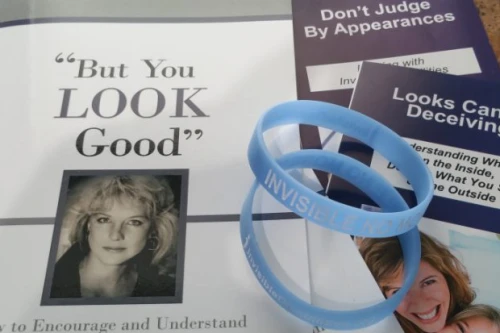
in·vis·i·ble dis·a·bil·i·ty
/inˈvizəb(ə)l/ /disəˈbilədē/
noun
People often ask us to define invisible disability. In simple terms, an invisible disability is a physical, mental or neurological condition that is not visible from the outside, yet can limit or challenge a person’s movements, senses, or activities. Unfortunately, the very fact that these symptoms are invisible can lead to misunderstandings, false perceptions, and judgments.
People are parking in an accessible parking space with a placard, but they look fine. I wonder if that driver has an invisible disability.
What is an invisible disability?

In general, the term disability is often used to describe an ongoing physical or mental challenge. This challenge could be a well-managed bump in life or a mountain that creates severe changes and loss. Either way, this term should not be used to describe a person as weaker or lesser than anyone else! Every person has a purpose, uniqueness, and value, no matter what hurdles they may face. When we define invisible disability, it helps us understand the subtle differences and challenges each person experiences in their daily lives.
Also, just because a person has a disability, does not mean they are disabled. Many living with these challenges are still fully active in their work, families, sports or hobbies. Some with disabilities can work full or part-time, but struggle to get through their day, with little or no energy for other things. Others are unable to maintain gainful or substantial employment due to their disability, have trouble with daily living activities and need assistance with their care.
According to the Americans with Disabilities Act of 1990 (ADA) an individual with a disability is a person who: Has a physical or mental impairment that substantially limits one or more major life activities; has a record of such an impairment, or is regarded as having such an impairment (Disability Discrimination).
Furthermore, “A person is considered to have a disability if he or she has difficulty performing certain functions (seeing, hearing, talking, walking, climbing stairs and lifting and carrying), or has difficulty performing activities of daily living, or has difficulty with certain social roles (doing school work for children, working at a job and around the house for adults)” (Disabilities Affect One-Fifth of All Americans). Given this basic knowledge, it is easy to see how work to define invisible disability is both critical to helping so many who are overlooked but also daunting in scope.
Defining invisible disability can open doors of communication and understanding.
Often people think the term, disability, only refers to people using a wheelchair or walker. On the contrary, the 1994-1995 Survey of Income and Program Participation (SIPP) found that 26 million Americans (almost 1 in 10) have a severe disability, while only 1.8 million used a wheelchair and 5.2 million used a cane, crutches or walker (Americans with Disabilities 94-95). In other words, 74% of Americans who live with a severe disability do not use such devices. Therefore, a disability cannot be determined solely by whether or not a person uses assistive equipment.
The term we define invisible disability refers to symptoms such as debilitating pain, fatigue, dizziness, cognitive dysfunctions, brain injuries, learning differences and mental health disorders, as well as hearing and vision impairments. These are not always obvious to the onlooker, but can sometimes or always limit daily activities, range from mild challenges to severe limitations, and vary from person to person.
Also, someone who has a visible impairment or uses an assistive device such as a wheelchair, walker or cane can have an invisible disability or invisible disabilities. For example, whether or not a person utilizes an assistive device, if they are debilitated by such symptoms as described above, they live with invisible disabilities.
Opportunities for dialog begin when we talk about invisible disabilities.
Unfortunately, people often judge others by what they see and conclude a person can or cannot do something by the way they look. This attitude can be equally frustrating for those who may appear unable but are perfectly capable, as well as those who seem able, but are not.
International Disability expert, Joni Eareckson Tada, explained it well when she told someone living with debilitating fatigue, “People have such high expectations of folks like you [with invisible disabilities], like, ‘come on, get your act together.’ But they have such low expectations of folks like me in wheelchairs, as though the thought is that we can’t do much” (Joni).
The bottom line is that everyone with a disability is different, with varying challenges and needs, as well as abilities and attributes. Thus, we all should learn to listen with our ears instead of judging with our eyes. That is the reason we define invisible disability.
LIST OF ILLNESSES THAT ARE CONSIDERED INVISIBLE DISABILITIES:
We do not maintain a list of specific illnesses and diagnoses that are considered invisible disabilities. Invisible disabilities are such symptoms as debilitating fatigue, pain, cognitive dysfunctions and mental disorders, as well as hearing and eyesight impairments and more.
There are thousands of illnesses, disorders, diseases, dysfunctions, congenital disabilities, impairments, and injuries that can be debilitating. Therefore, all conditions that are debilitating are taken into consideration when we talk about invisible disabilities throughout the website. However, our focus is not to attempt to provide a vast amount of information about thousands of specific conditions (there are plenty of sites that do that).
We are here to provide awareness, education, connection and support for everyone who lives with a debilitating condition. We do this by offering articles, pamphlets, booklets, resources, radio, video, seminars and more to give hope and compassion to all living with invisible disabilities as well as information for loved ones to better understand.
If you would like to suggest a link to an organization or foundation that provides information about your specific condition, please send it to us through the contact page. We would love to hear about it!





